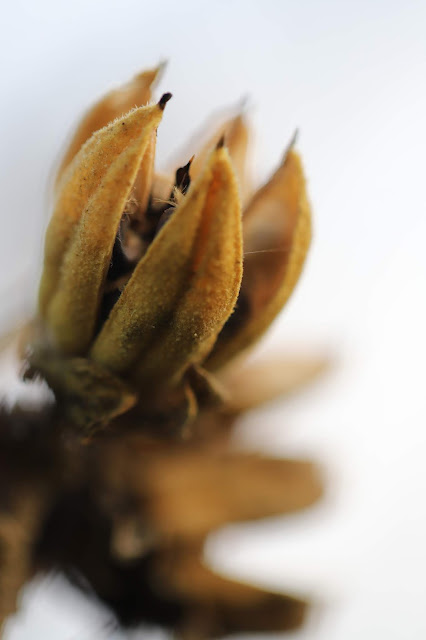I love the Canon EOS 6D Mark II camera along with a macro 100mm lens that I got two winters ago during the holiday season of 2017. Since it is a complicated bit of equipment, and I wanted to use it as quickly as possible, that is, not in its fully manual mode, nor in its completely automated and unchallenging role, I went for partial automation, to be precise, I chose aperture priority mode, meaning, I get to choose how wide the lens is positioned, while the camera does everything else. En bref, on my camera the lowest f-stop of 2.8 denotes the widest lens opening letting in the most light but providing the least depth of field. It is fantastic for producing the desirable bokeh effect where the background is gorgeously diffused.
For a mixed depth of field, where the whitish rock is in the sharpest focus, the broken terracotta roofing tiles are less, and the cement background blurred, I chose f/16.
For the fullest depth of field and also to cut down on glare contributed by city lights, I picked the highest, that is, f/32.
To get decent depth of field for this shot of frozen birdbath water dumped onto the grass, I also selected f/32 while being straddled over the subjects.
Knowing I wanted to let in as much light without sacrificing the frosty details of these penstemons, I picked f/9.
For these unfurling rhubarb buds, as light was less of a problem and I wanted to get as many closeup details as possible without losing the bokeh effect, I dialed to f/20.
I am looking forward to using more and more features on this beauty of a camera. But in general, I keep my photography simple, practical, and fun. The photos also inspire my coloured pencil artwork. I have taken a couple of Coursera classes which I recommend:
Seeing Through Photography
Photography Basics and Beyond (I just audited it for no cost)
À la prochaine!
 |
| Rain on windowpane |
 |
| Rose of Sharon's burst seed pod |
 |
| Fluffy aster seed pods |
 |
| Rose thorn |
 |
| Red berry on an aucuba |
For a mixed depth of field, where the whitish rock is in the sharpest focus, the broken terracotta roofing tiles are less, and the cement background blurred, I chose f/16.
For the fullest depth of field and also to cut down on glare contributed by city lights, I picked the highest, that is, f/32.
 |
| Factory chimney bathed in the light of the crescent moon? No, it has floodlights on it! |
To get decent depth of field for this shot of frozen birdbath water dumped onto the grass, I also selected f/32 while being straddled over the subjects.
Knowing I wanted to let in as much light without sacrificing the frosty details of these penstemons, I picked f/9.
For these unfurling rhubarb buds, as light was less of a problem and I wanted to get as many closeup details as possible without losing the bokeh effect, I dialed to f/20.
I am looking forward to using more and more features on this beauty of a camera. But in general, I keep my photography simple, practical, and fun. The photos also inspire my coloured pencil artwork. I have taken a couple of Coursera classes which I recommend:
Seeing Through Photography
Photography Basics and Beyond (I just audited it for no cost)
À la prochaine!



